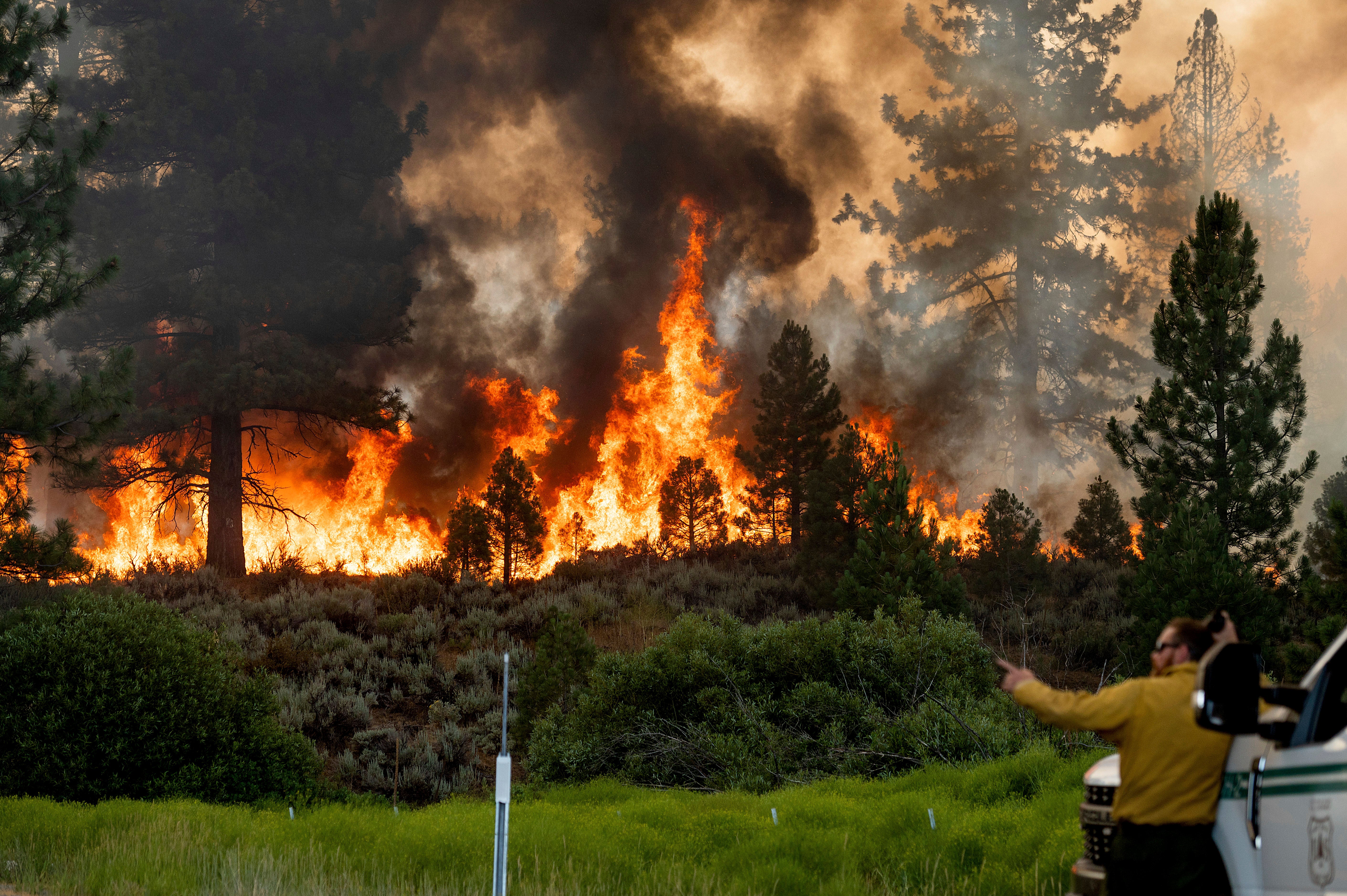Surging California wildfire prompts Nevada evacuations
A Northern California wildfire exploding through bone-dry timber has prompted Nevada authorities to evacuate a border-area community

Your support helps us to tell the story
From reproductive rights to climate change to Big Tech, The Independent is on the ground when the story is developing. Whether it's investigating the financials of Elon Musk's pro-Trump PAC or producing our latest documentary, 'The A Word', which shines a light on the American women fighting for reproductive rights, we know how important it is to parse out the facts from the messaging.
At such a critical moment in US history, we need reporters on the ground. Your donation allows us to keep sending journalists to speak to both sides of the story.
The Independent is trusted by Americans across the entire political spectrum. And unlike many other quality news outlets, we choose not to lock Americans out of our reporting and analysis with paywalls. We believe quality journalism should be available to everyone, paid for by those who can afford it.
Your support makes all the difference.A Northern California wildfire exploding through bone-dry timber prompted Nevada authorities to evacuate a border-area community as flames leapt on ridgetops of nearby mountains.
The Beckwourth Complex — a merging of two lightning-caused fires — headed into Saturday showing no sign of slowing its rush northeast from the Sierra Nevada forest region after doubling in size only a few days earlier.
The fire was one of several threatening homes across Western states that are expected to see triple-digit heat through the weekend as a high-pressure zone blankets the region.
On Friday, Death Valley National Park in California recorded a staggering high of 130 degrees Fahrenheit (54.4 Celsius). If verified, it would be the hottest high recorded there since July 1913, when the same Furnace Creek desert area hit 134 degrees Fahrenheit (56.6 degrees Celsius), considered the highest reliably measured temperature on Earth.
California's northern mountain areas already have seen several large fires that have destroyed more than a dozen homes. Although there are no confirmed reports of building damage, the fire prompted evacuation orders or warnings for hundreds of homes and several campgrounds in California along with the closure of nearly 200 square miles (518 square kilometers) of Plumas National Forest.
On Friday, ridgetop winds up to 20 mph (32.2 kph) combined with ferocious heat as the fire raged through bone-dry pine, fir and chaparral. As the fire's northeastern flank raged near the border, the Washoe County Sheriff's Office asked people to evacuate some areas in the rural communities of Ranch Haven and Flanagan Flats, north of Reno.
“Evacuate now,” a Sheriff’s Office tweet said.
Hot rising air formed a gigantic, smoky pyrocumulus cloud that reached thousands of feet high and created its own lightning, fire information officer Lisa Cox said Friday evening.
Spot fires caused by embers leapt up to a mile (1.6 kilometers) ahead of the northeastern flank — too far for firefighters to safely battle, and winds funneled the fire up draws and canyons full of dry fuel, where “it can actually pick up speed,” Cox said.
Nearly 1,000 firefighters were aided by aircraft but the blaze was expected to continue forging ahead because of the heat and low humidity that dried out vegetation. The air was so dry that some of the water dropped by aircraft evaporated before reaching the ground, Cox said.
“We’re expecting more of the same the day after and the day after and the day after,” Cox said.
The blaze, which was only 11% contained, officially had blackened more than 38 square miles (98 square kilometers) but that figure was expected to increase dramatically when fire officials were able to make better observations.
Meanwhile, other fires were burning in Oregon, Arizona and Idaho
In Oregon, pushed by strong winds, a wildfire in Klamath County grew from nearly 26 square miles (67 square kilometers) Thursday to nearly 61 square miles (158 square kilometers) on Friday in the Fremont-Winema National Forest and on private land. An evacuation order was issued for people in certain areas north of Beatty and near Sprague River.
That fire was threatening transmission lines that send electricity to California, which along with expected heat-related demand prompted California Gov. Gavin Newsom on Friday to issue an emergency proclamation suspending some rules to allow for more power capacity.
The state's electrical grid operator also issued a statewide Flex Alert from 4 p.m. to 9 p.m. Saturday, calling for consumers to voluntarily conserve electricity by reducing the use of appliances and keeping the thermostat higher during evening hours when solar energy is diminished or no longer available.
In north-central Arizona, increased humidity slowed a big wildfire that posed a threat to the rural community of Crown King. The 24.5-square-mile (63.5-square-kilometer) lightning-caused fire in Yavapai County was 29% contained. Recent rains allowed five national forests and state land managers to lift public-access closures.
In Idaho, Gov. Brad Little declared a wildfire emergency Friday and mobilized the state’s National Guard to help fight fires sparked after lightning storms swept across the drought-stricken region.
Fire crews in north-central Idaho were facing extreme conditions and gusts as they fought two wildfires covering a combined 19.5 square miles (50.5 square kilometers). The blazes threatened homes and forced evacuations in the tiny, remote community of Dixie about 40 miles (64 kilometers) southeast of Grangeville.